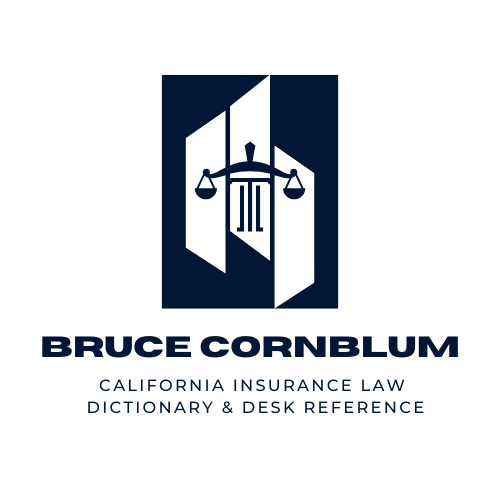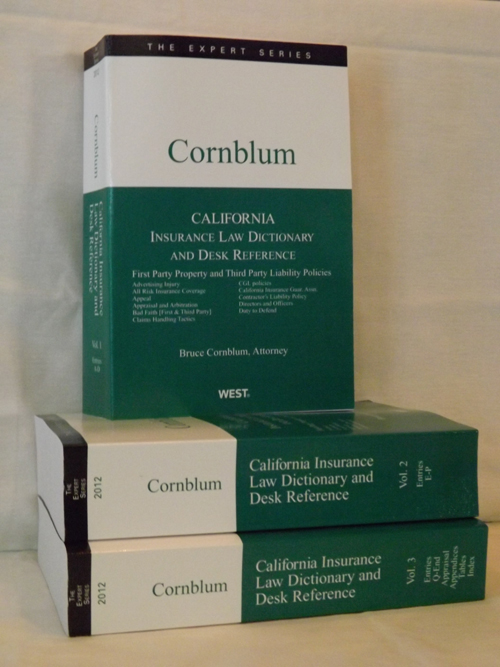Coverage provided by products-completed operations hazard
Standard language of the products-completed operations hazard coverage employs standard language promising the insured coverage against claims for property damage ‘arising out of … ‘your work’ except for … work that has not yet been completed’. This type of coverage ordinarily is conditioned on damage occurring during the policy period, as long as the work was completed before the damage occurred, and is not conditioned on when the work was completed. The protection provided by this products-completed operations hazard provision appears to require three conditions:
1. there was property damage,
2. it arose ‘out of your work’ and, [see § W21.02 WORK]*
3. ‘your work’ has been COMPLETED. [see § P95 PRODUCTS HAZARD [§ P95:2.1 Date of occurrence]]
Nothing in the products-completed operations hazard suggests the second (2) element – the insured’s work caused the damage – was itself subject to a fourth condition that the insured’s work happened during the policy period. [Pennsylvania General Ins. v. American Safety Indem. Co. (2010) 185 Cal.App.4th 1515, 1532-1533, 111 Cal.Rptr.3d 403] Thus, with regards to the second (2) element – the insured’s work caused the damage –, ‘your work’ could have happened prior to the policy period. [Pennsylvania General Ins. v. American Safety Indem. Co. (2010) 185 Cal.App.4th 1515, 1533, 111 Cal.Rptr.3d 403] See § O5 OCCURRENCE [§ O5:5.1]
‘Work in progress’ ‘damage’ occurring ‘during’ the policy period is not completed operations
A CGL policy defines ‘occurrence’ as an accident, including continuous or repeated exposure to the same general harmful conditions. See § O5 OCCURRENCE/ACCIDENT, §§ O5:3.1 – O5:4. The insuring agreement states that: “We will pay those sums as damages because of … ‘property damage’ to which this insurance applies …” “This insurance applies to bodily injury or property damage only if the bodily injury or property damage occurs during the policy period.” See § P61 POLICY TERM [§P61:2 Insuring clauses requiring loss or damage during the policy term].
CGL exclusion j(5); does not apply to “completed operations”
Exclusion j(5) applies to damages involving ‘work in progress’. Exclusion j(5) does not apply to completed operations. [Advantage Home Building LLC v. Maryland Cas. Co. (2006, 10th Cir.) 470 F.3d 1003, 1010-1011 (contractor installed damaged-defective windows, damaged during construction but discovered only after homeowner moved in)] See § C107 CONTRACTOR’S LIABILITY POLICY [§ C107:17].
Manifestation of damage before expiration of policy term; significance of
An EVENT causing loss or damage that does not manifest [see § M14:5 Liability policy] before the expiration of the policy term is not covered under a CGL policy not containing completed operations coverage. § P61 POLICY TERM (PERIOD) [§ P61:1]. A product liability policy in effect when the defective product was manufactured does not cover a claim for injuries suffered seven years later. Schrillo Co. v. Hartford Acc. (1986) 181 Cal.App.3d 766, 773, 226 Cal.Rptr. 717] Thus, if a contractor installed a gas boiler which, six years later, caused a fire to the home, the contractor’s liability policy in effect at the time of the negligent installation, would not cover the loss. [Maples v. Aetna (1978) 83 Cal.App.3d 641, 647, 148 Cal.Rptr. 8] However, if the same contractor had a CGL policy in effect six years later when the damage occurred, this policy would cover the contractor. [Garriott Crop v. Superior Court (1990) 221 Cal.App.3d 783, 270 Cal.Rptr. 678] See § M14 MANIFESTATION OF DAMAGE [§ M14:5 Liability policy].
A contractor or subcontractor may allow the CGL policy in effect when the construction work is taking place to lapse with no CGL policy taking its place. Based upon the above, if the contractor or subcontractor caused defective work, but such defective work did not cause damage until after work was completed, there would be no coverage available to the contractor or subcontractor. The way that this can be prevented is if a contractor or subcontractor requested the inclusion of ‘products-completed operations coverage’. [See Hawkeye Security Ins. v. Davis (1999, Ct. App. Mo.) 6 S.W.3d 419, 424; Pardee v. Ins. Co. West (2000) 77 Cal.App.4th 1340, 1360-1361, 92 Cal.Rptr.2d 443 (“Damage resulting from subcontractor’s work often does not arise for years. It is thus prudent for general contractors to obtain completed operations coverage …”.)]
‘Completed operations’ coverage is supplemental coverage to coverage A and is not a separate policy.
Completed operations coverage affords the same type of coverage for damages occurring after completion of the insured’s work and away from the insured’s premises. The ‘products-completed operations hazard’ is not a separate policy but a SUBPART of the entire policy. [American Home Assur. v. AGM Marine Contractors (2005 D.C. Mass.) 379 F.Supp.2d 134, 136 (no coverage under completed operations provision where an occurrence did not happen during the policy term)] This provision, when properly construed as a subpart of the entire policy, describes coverage within the policy for the same type of injuries or damages covered by the rest of the policy save for a different period of time. [Hawkeye Security Ins., supra, 6 S.W.3d at p. 425 (absent an accident or occurrence during the policy term, builders warranties were not covered under ‘products-completed operations’.
‘Premises operations’ coverage/occurrence coverage applies when property damage occurs during the policy period
It is important to distinguish between an (1) accident occurring during the policy term which does not cause damage from (2) an accident or occurrence that occurs during the policy term which causes damage during the policy term. As seen above INJURY or DAMAGE must ‘occur’ during the policy term for there to be coverage under a CGL policy. See § P61 POLICY TERM (PERIOD) [§ P61:4]. Under a CGL policy property damage may occur even though its occurrence did not manifest itself during the policy period. The third party CGL policy does not impose, as a condition of coverage, a requirement that the damage or injury be discovered in any particular point in time. [County of San Bernardino v. Pacific Indem. Co. (1997) 56 Cal.App.4th 666, 684, 65 Cal.Rptr.2d 657]
Continuous or progressive damage covered under ‘occurrence/operations’ not under completed operations coverage
In continuous or progressive damage third party liability cases resulting in bodily injury or property damage, the ‘trigger’ (e.g. injury or damage) for coverage can occur before or during the policy period. Either is the date of discovery of the damage or injury controlling. It might or might not be contemporaneous with the causal event (e.g. negligent act). It is only the EFFECT – the occurrence of bodily injury or property damage during the policy period, resulting from a sudden accident or the ‘continuous or repeated exposure to conditions’ – that triggers potential liability coverage. [Montrose Chem. Corp. v. Admiral Ins. (1995) 10 Cal.4th 645, 675, 42 Cal.Rptr.2d 324, 340]
Concealed deficiencies in real property
Concealed injury or damage, those defects that are not apparent during a reasonable inspection are covered under a CGL policy where the deficiencies (e.g. injury or damage), caused by the insured’s negligent design and construction, gives rise to claims for ‘property damage’ during the policy term. This is so even though the policy’s extending coverage to the insured have expired before the third party purchaser discovers the loss. [Century Indem. v. Hearrean (2002) 98 Cal.App.4th 734, 740, 120 Cal.Rptr.2d 66] See § D62 DISCOVERY OF PROPERTY DAMAGE [§ D62:3]
Meaning of “does not apply to property damage included in the ‘products-completed operations’ hazard”
Exclusion j(6) as it relates to ‘products-completed operations’ hazard is intended to exclude coverage for the cost of restoring, repairing or replacing faulty workmanship on the part of the insured, its contractors and subcontractors. More specifically, it is intended to exclude property damage that directly or consequentially occurs from the FAULTY WORKMANSHIP of the insured and its contractors/subcontractors (i.e. work that is ‘incorrectly’ performed while the work is ‘ongoing’). [Advantage Home Building LLC v. Maryland Cas. Co. (2006, 10th Cir.) 470 F.3d 1003, 1012] Exclusion j(6) is intended to bar defective workmanship claims. The express exception to exclusion j(6) allows an insured to recover consequential damages that arise out of his or her faulty workmanship AFTER THE COMPLETION OF THE WORK. [Advantage Home Building LLC v. Maryland Cas. Co. (2006, 10th Cir.) 470 F.3d 1003, 101012]
ILLUSTRATION [Damage occurring after work completed]:
Assume that a contractor is building a home for a third party. The contractor first erects the walls and completes the roof and then begins finishing the interior. Unfortunately, the roofing was poorly installed and later leaks, thereby damaging partially completed parquet floors. The damage to the floors [which was a consequence of the faulty workmanship that occurred at a time after the work was completed] would be covered but replacement of the poorly constructed roof [which was the direct result of faulty workmanship that occurred while the work was ongoing] would be EXCLUDED. [Advantage Home Building LLC v. Maryland Cas. Co. (2006, 10th Cir.) 470 F.3d 1003, 1012]
* BOLD references are to the 2-volume treatise entitled CALIFORNIA INSURANCE LAW DICTIONARY AND DESK REFERENCE (4000 pages, 2010 Ed.), which can be purchased from West Publishing at 1-800-328-4880 1-800-328-4880.
1-800-328-4880.

